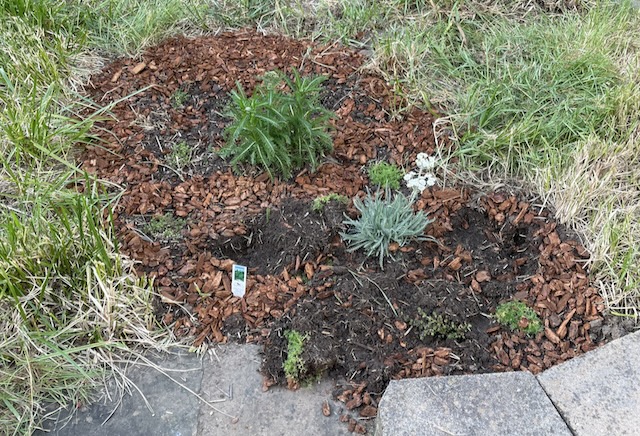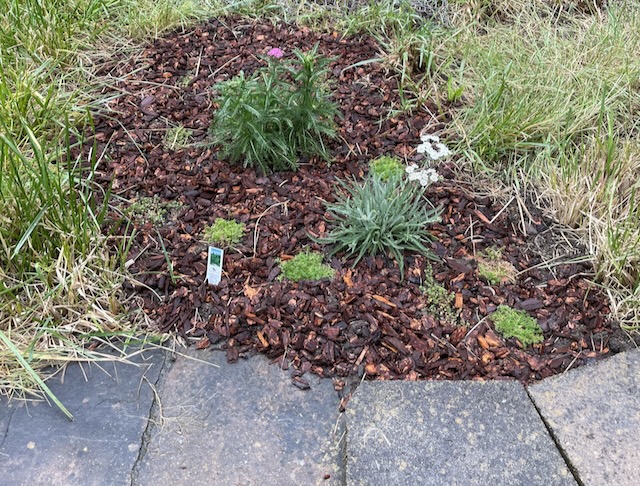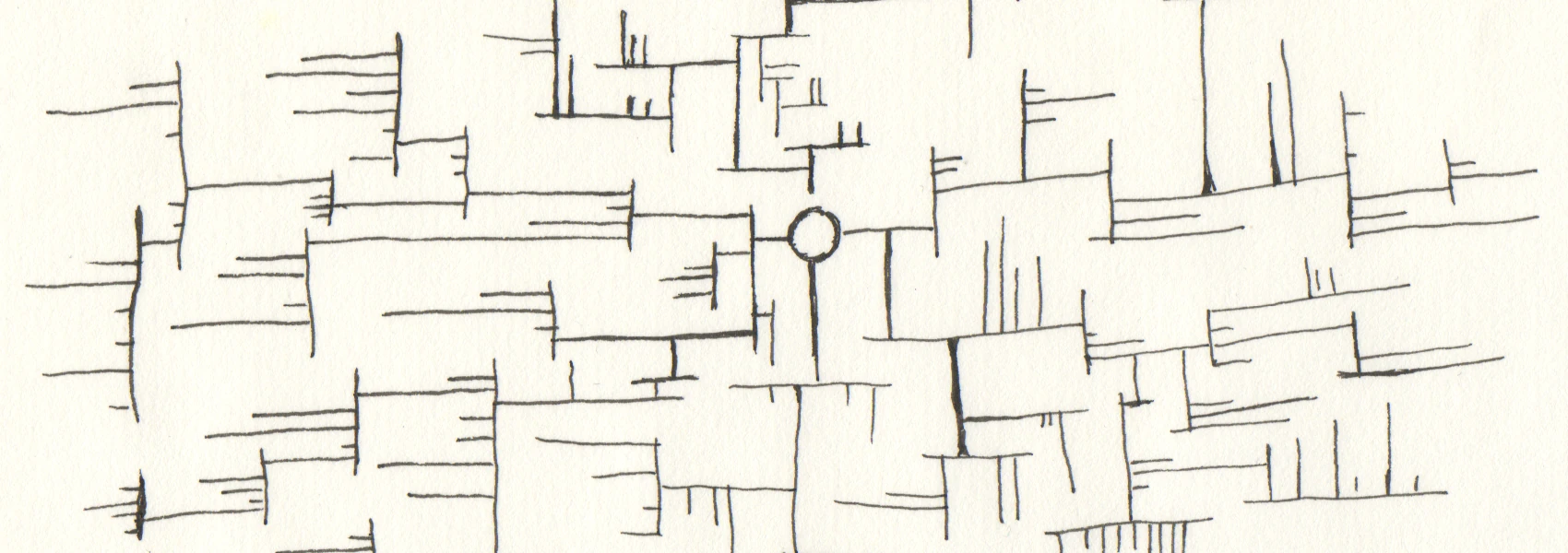One of my favorite poems of all time is Kenneth Koch’s “One Train May Hide Another.” The poem begins with its titular image and immediately starts playing with it:
In a poem, one line may hide another line,
As at a crossing, one train may hide another train.
That is, if you are waiting to cross
The tracks, wait to do it for one moment at
Least after the first train is gone. And so when you read
Wait until you have read the next line—
Then it is safe to go on reading.
The poem gets stranger and richer from there, and you might as well go read it.
I think of that poem and that phrase “one train may hide another,” when I’m fixing a problem of some kind, and only when I fix the first problem, do I discover the problem behind it. Sometimes one after another, revealing themselves only after the previous problems are fixed.
One garden pest may hide another #
I’ve been gardening lately, trying to turn the little lawn in my backyard into a California native plant sanctuary. The grass dies back in the summer, even with watering, and it’s not very attractive. At first, I decided to cut it back, hoping that if I cut the yellowing grass on top, I’d let the grass from the bottom grow in. I bought a string trimmer and strimmed the tall grass. Strimming, by the way, is a ton of fun. My strimmer is electric battery-powered so it’s not smelly or very loud, and I just swoosh that sucker around while thinking, “Die ugly grass, die!”
After I cut it back, I realized the tall, dry grass was actually covering patches of entirely bare ground. Not great. But, it also gave me an excuse to start planting stuff. I took my wheely cart thing on the bus and rode down to the nursery where I bought some drought-resistant plants and 40 pounds of mulch. Taking mulch home on the bus in a wheely thing was a bit challenging. Luckily, the bus sits low to the curb and doesn’t have steps, so I was able to do it.
While digging up dead grass with my tiny hand trowel (because the shovel I have sucks), I noticed there was green plastic in the ground. When I ripped up some bigger chunks of it, I found it was a kind of wide plastic mesh. I wondered irately what the hell it was as I ripped it out. Stupid plastic in my ground. What the hell? (Yeah, I’ll come back to this)
A bunch of digging and planting and watering and mulching later, I had my first patch of plants in. They looked nice. I felt so proud of them! Gardening even a small patch is tons of work, yet somehow so compelling and satisfying that I can spend most of the day mucking about and feel happy about it.
The only thing I worried about was the squirrels. A lot of squirrels visit my yard and dig holes in it. I hoped the mulch would discourage them and I also had a stern conversation with some of them. I used hand gestures to indicate I had my eye on them. It seemed to work, at first.
Squirrels!? #
A few days later, the peace was over. I went to water my plants in the morning and found several had been dug up. Just entire plugs of chamomile plantings dug out of the ground and left lying sideways on top. Even for the brazen squirrels of my neighborhood, this was truly an act of uncalled-for vandalism. I photographed the crime scene and then put things back and added flesh mulch for good measure.

Then, I took to Mastodon to complain and tell the story of my squirrel woes, where I got sympathy and something even better: someone said it wasn’t squirrels but a skunk looking for grubs. I read a bit and found that indeed, this is the behavior of skunks. Young plants attract grubs and other bugs to their tasty roots, and those bugs attract skunks who dig them up to get at the bugs.
As it happened, when I was digging up the grass, I noticed a lot of little roly-poly bugs. I assumed they must have an important job in the ecosystem since there were so many of them. I decided to look them up and what do you know, they’re also called pill bugs and they are well, they’re frenemies. On the one hand, they eat dead plant matter, breaking it down into dirt. On the other hand, if they happen upon tasty new plant roots while eating dead plants, they’ll eat that, too. And my yard had been somewhat unkempt, with lots of dead grass among the living grass, and lots of leaves piling up in the corners. Pill bug central.
I thought I had a squirrel problem, but actually I had a skunk problem, but actually I had a pill bug problem, but actually–
Actually, I had an unkempt garden problem. The skunks were drawn to my plants because they had pill bugs all over. The pill bugs were all over my plants because they were all over the dead plant matter in my garden. I was going to have to clear it out. Along with various mildly murderous suggestions (I refuse to use even diatomaceous earth because it might kill bugs who are definitely friends, like spiders), I found the suggestion to make a leaf and garden trash pile to bait the pill bugs into. That seemed like a nice idea: make a pill bug habitat in a designated part of the garden and move them as I catch them. They don’t bite or even look that gross.
A rake that doesn't suck #
The following weekend I went on a big adventure to buy a garden rake. It took me a while to figure out that the kind of rake I wanted is called a garden rake. During the research process, I asked ChatGPT “Why do American rakes suck,” hoping it would tell me what they were called, but it just scolded me for being bigoted against Americans. American rakes suck, as it turns out, because they are specialized leaf rakes for gently caressing the leaves that fall on your grass. I thought they sucked because they were designed so you couldn't stand on them and bonk yourself on the head and were willing to be ineffective in exchange.
Anyway, I got a decent rake and raked the dead grass out of the grass and piled it all up in the back of the yard on top of a tree stump that I'm hoping to slowly break down with the natural process of decay. Now, every time I find a pill bug as I’m messing about in the garden (which I do constantly because I mostly work from home and I go out there every time I need a stretch break and pick a single weed) I pick that sucker up and carry it over to the grass and leaf pile.
Towards the fall, I also plan to inoculate the stump with some saprophytic fungi like shiitakes to help break it down some more, and maybe even get some edible mushrooms out of it. I can’t wait to find out what kind of weird problems that will uncover.
Oh and that weird plastic stuff I angrily ripped out of my lawn? It was plastic mesh netting that is sometimes used to put down turf, but also, to keep animals from digging up your lawn. So when I ripped it out of the part of the lawn I replaced with drought-resistant plants, I made it easier for animals to dig up digger chunks of lawn than the little holes the squirrels had been digging. I still hate the plastic stuff and plan to rip it up but at least I understand why someone might have thought it was a good idea once.

